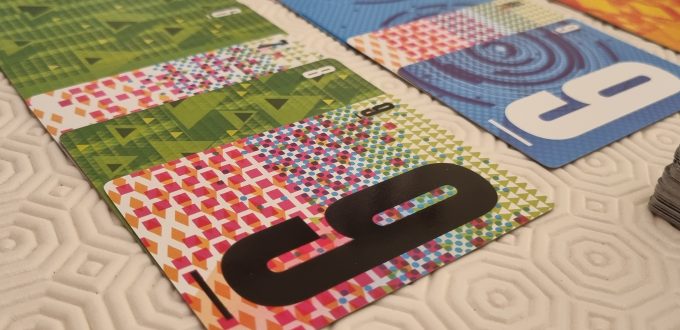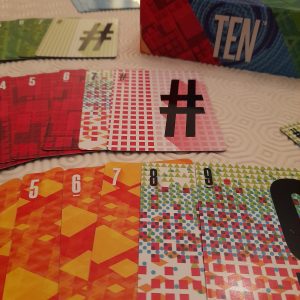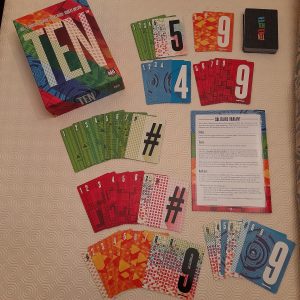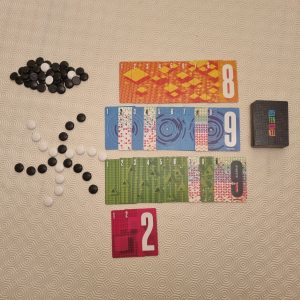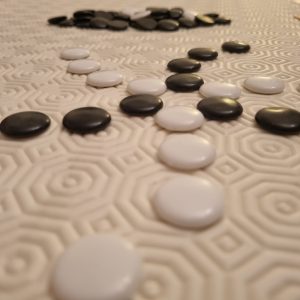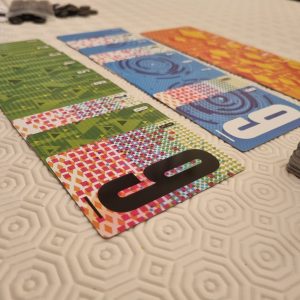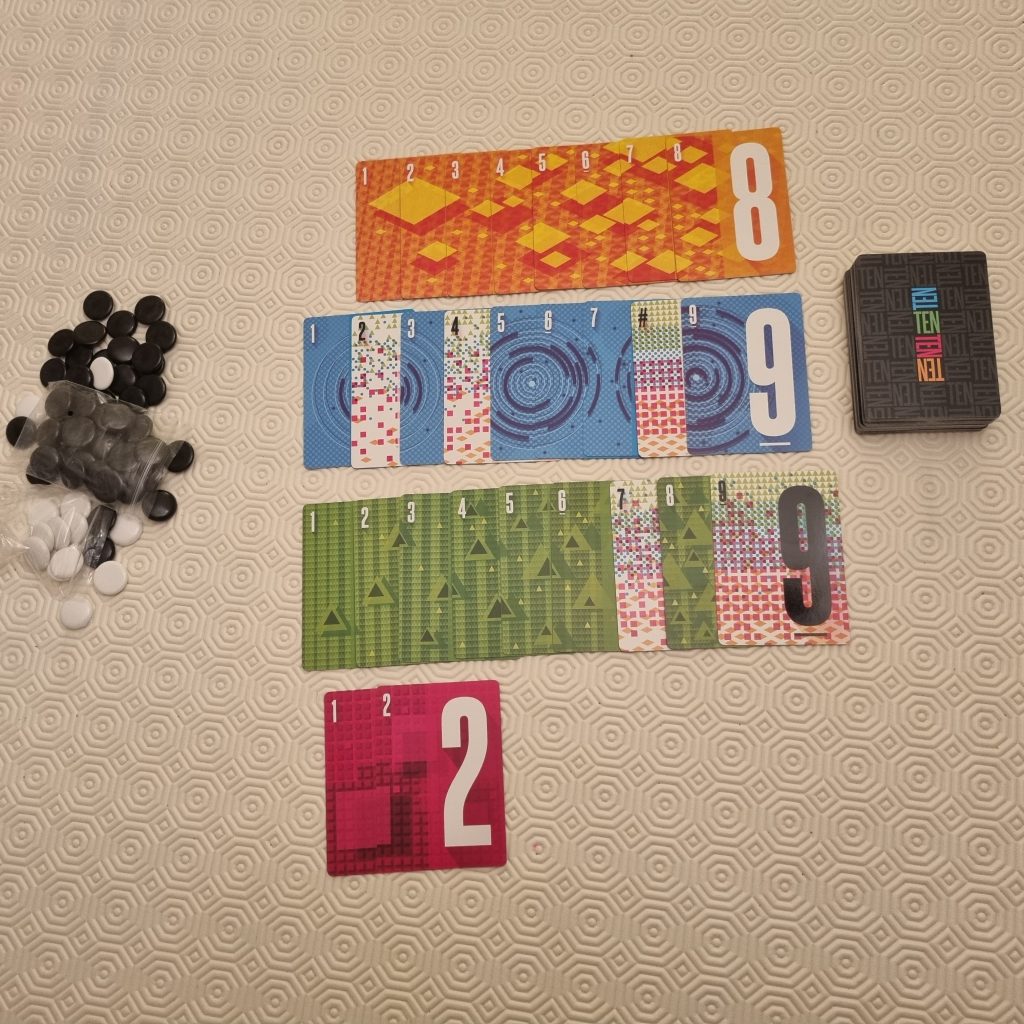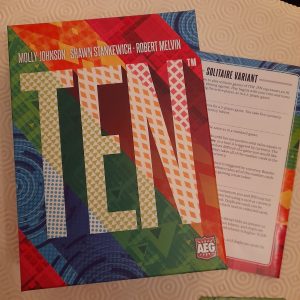New from AEG and Flatout games, TEN is a fun, vibrant, clever set collection game with a real “twist”! Question is; can you hold your nerve?
Publisher: Alderac Entertainment Group (AEG), Flatout Games
Designer: Molly Johnson, Robert Melvin, Shawn Stankewich
Artist: Shawn Stankewich
Release date: 2021
1-5 Players
Age: 10+
15 – 20 mins
Favouritefoe score: 9/10
Auction * Set Collection * Hand Management * Push-Your-Luck- Memory * Card * Solo *
TWIST…..TWIST……BUST!
I used to think that three was the magic number (thanks to THAT rather catchy tune). Having recently played TEN, however, I now know that I was wrong. TEN is the magic number. Or at least eleven most definitely is not.
And that is because, in TEN, the number 10 literally means safe. 10 means lots of lovely cards. 10 means copious currency. 10 means victory.
Eleven on the other hand means none of those things. The most you’ll get for 11 is a little white circular token and a guaranteed face-palm! Why? Well, because in TEN, 11 means you went too far. 11 means you were a greedy-pants. 11 means you went BUST!
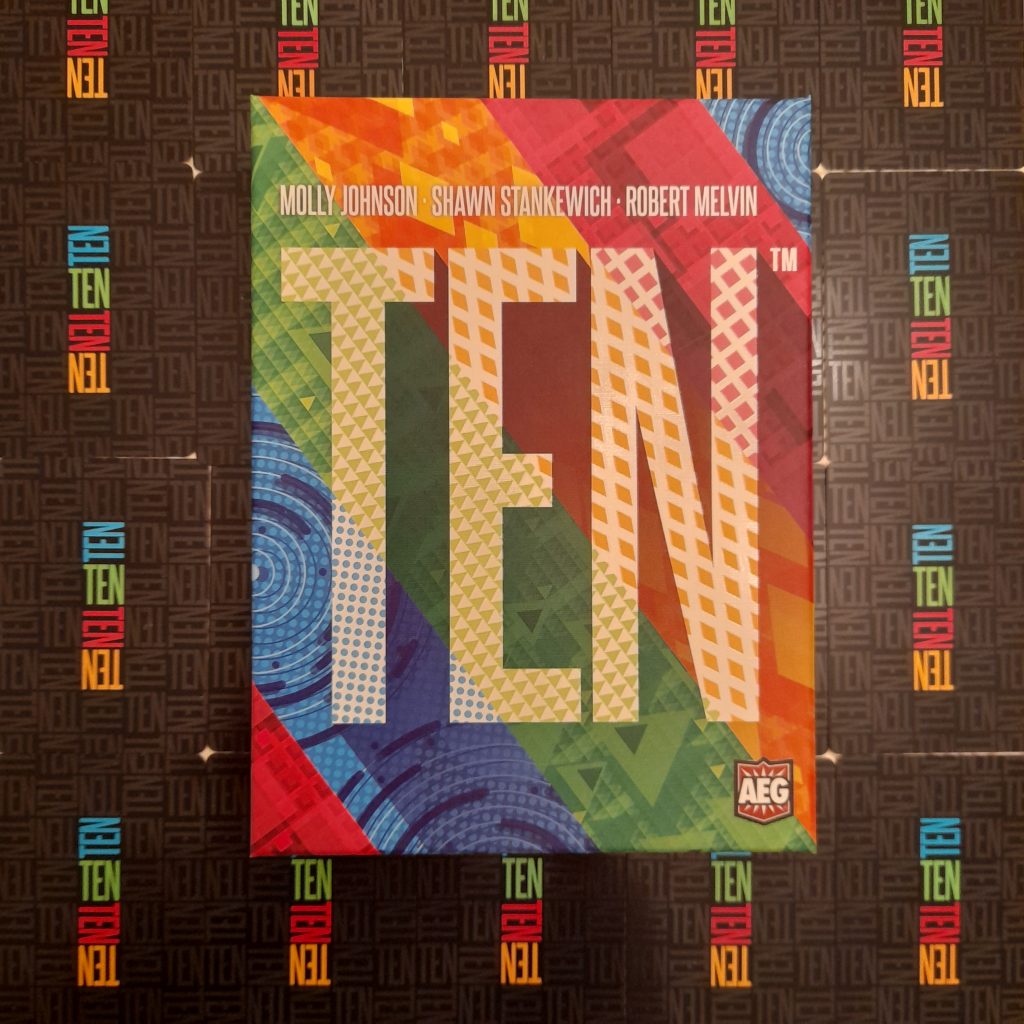
Don’t be fooled; the temptation to push your luck beyond your logical limit when playing TEN is irresistible! “Just one more” you’ll say to yourself. “It will be ok. Just one more”…….
You want lots of cards. You need lots of cards. But you specifically want unbroken runs of consecutive numbers in the four different coloured sets by game end. Why? Well, because only consecutive cards in your longest run in each colour score a point. Plus, if you manage to get 0 through 9 in any given colour, you’ll get a bonus point bringing that set value up to TEN!
So how do you get to the glorious ten in TEN? Read on to find out!
Set Up!
If you have ever played Pontoon or 21s, you’ll already know the basic premise of this game. Having shuffled the deck of player appropriate number and currency cards, and disributed 5 black currency tokens to everybody, the first player goes for it, and flips over the top card of the deck.
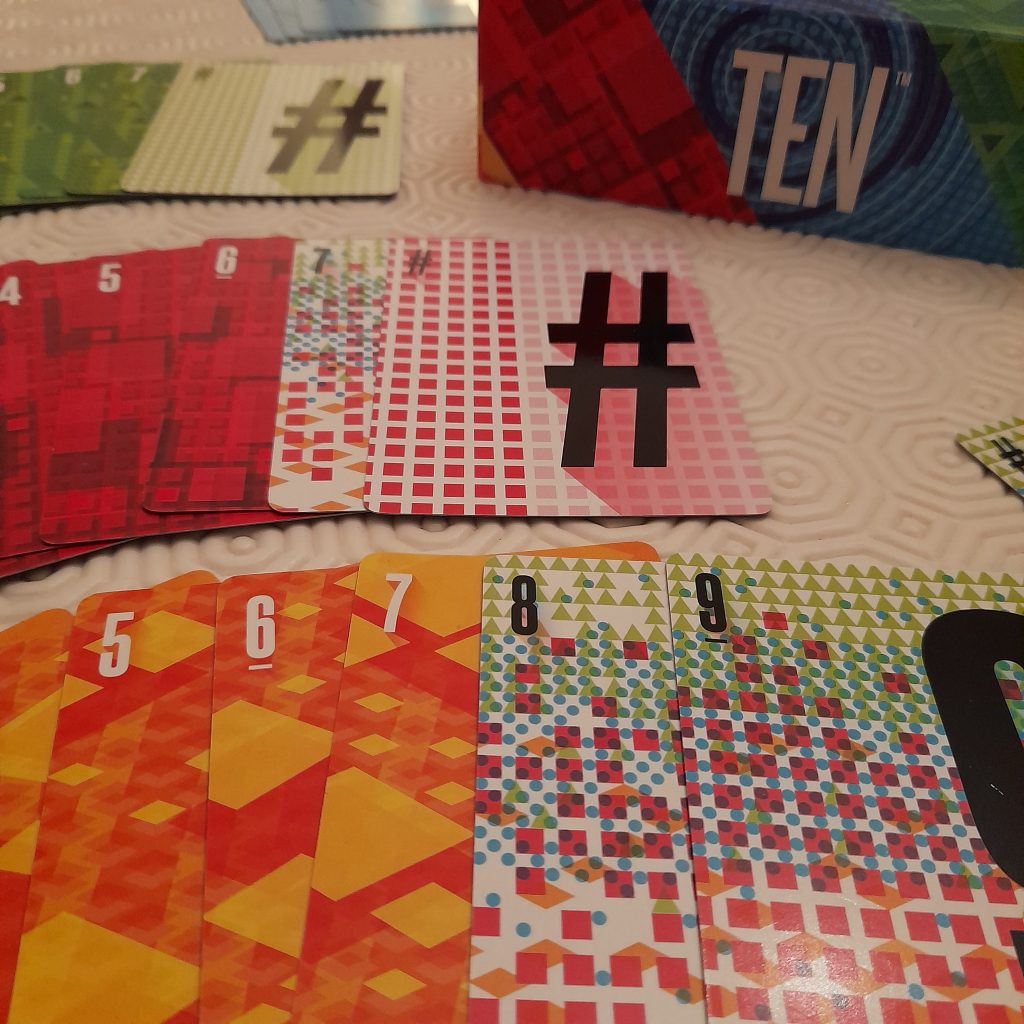
Pontooning Around!
Health warning; this game is incredibly simple to play once you get the hang of it. It’s not even a complicated game, but the rules are a little bit confusing straight off the page. It is definitely one that is much easier to pick up by watching. And That’s not a direct criticism of the author – it can be very hard to explain game flow in a short, succinct way.. And I can’t promise I’ll do a better job than the book (or the supplementary rule insert) either. But I’ll break down a round just in case it helps.
On your turn, twist or stick; the choice is yours. You can turn over as many cards as you dare so long as neither (a) the number card total nor (b) the currency card total add up to 11 or more.
So far, so reasonably familiar.
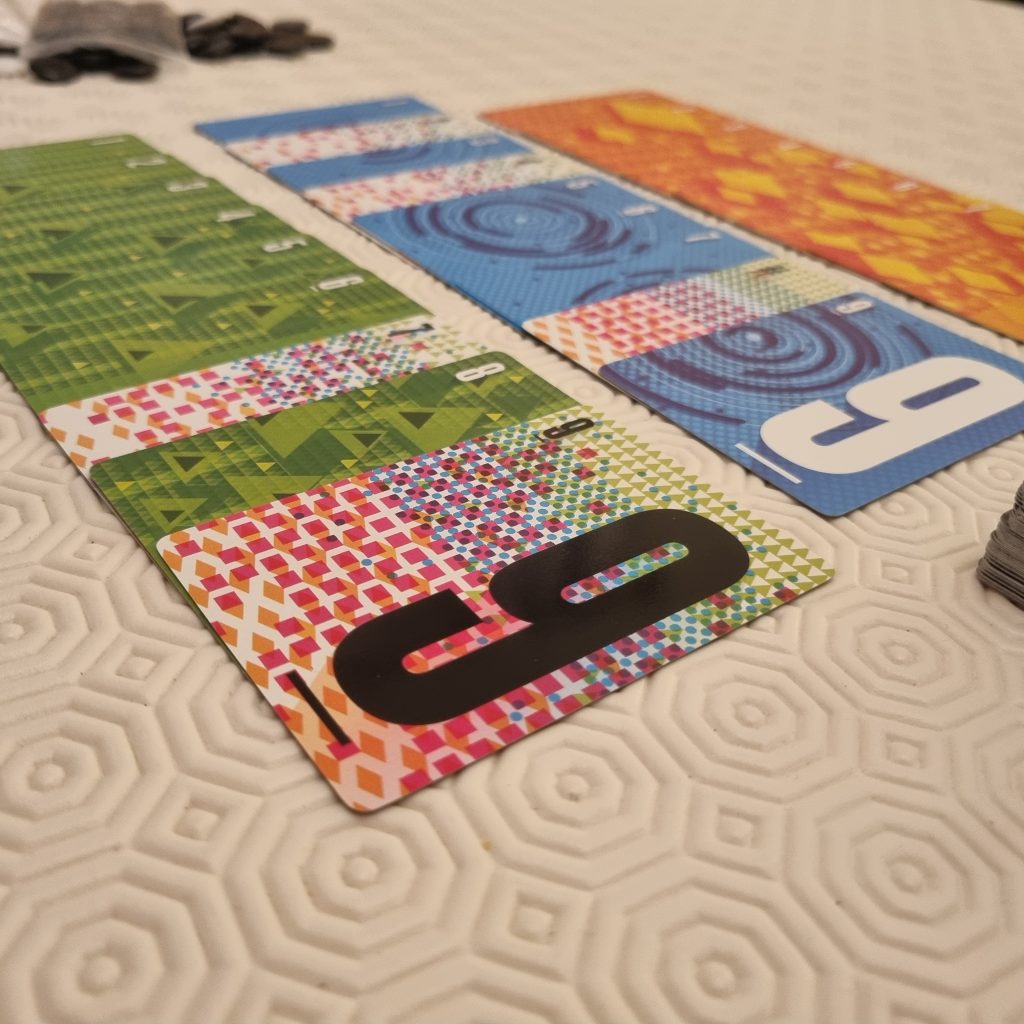
But, until the currency card total hits 11, their value gets deducted from the total of the number cards showing along the line. For example, a run of “2N-3N-5C-2N-1C” cards would ordinarily total 13 i.e. you BUST!. But if the 5 and the 1 are in fact currency cards (“C”), then the true “N” total is only 1 (7N minus 6C) i.e. well and truly SAFE!
Now, you could decide to STICK there, and take the N cards. If you do, add the 2N, 3N and 2N cards to your own pile. The C cards get discarded, but your opponents gain their value in the form of black currency tokens. I should note that each player can only hold a maximum of 10 of these throughout the game.
If you don’t stick but carry on turning over cards until either the numbers or currency exceed 11, you will BUST! Doh! In that case, you don’t get the number cards. Instead, they go into a separate space called “the market”. All is not lost, however, as you do get a white BUST token valued at 3 currency. Oh, and if you bust on the number cards, your opponents still get paid for any revealed currency cards – the price for being a greedy-pants is high!

This Little Player Went To Market….!
When the next player has their turn, they will do the same thing; flip card, breathe out, sweat, decide whether to go for another……. If they stop turning over cards before going BUST, they will take the number cards. And, just like before, everyone else will earn currency if any C cards were in the mix. But this time, with number cards in the market, the active player can go shopping!
Well, they can if they can afford it. And they will be pockets-deep if they have enough tokens (note any card in hand is also valued at 1 for buying purposes). So a green 3 will cost 3 tokens, a blue 7 will cost 7 tokens etc. They don’t have to go on a spree, of course. But if they want to, they can buy any one card from the market.
Now, the market can be a very useful place to go if you need a specific card. Plus it’s just sitting there, tempting you. But there are other ways to gain number cards. And this is through the integrated auction mechanic.
So, whenever a wild card (number/colour/both) is flipped, play is temporarily paused. STOP!!! Each player then gets to bid, and the biggest spender wins that card. Paying the bid tokens and or cards to the bank, the buyer takes the wild card into their pile, and then the active player resumes their turn.
And round the game goes until the deck is depleted. When that happens, each player scores their longest run in each colour (1 point per consecutive card), and the player with the most points in total wins!
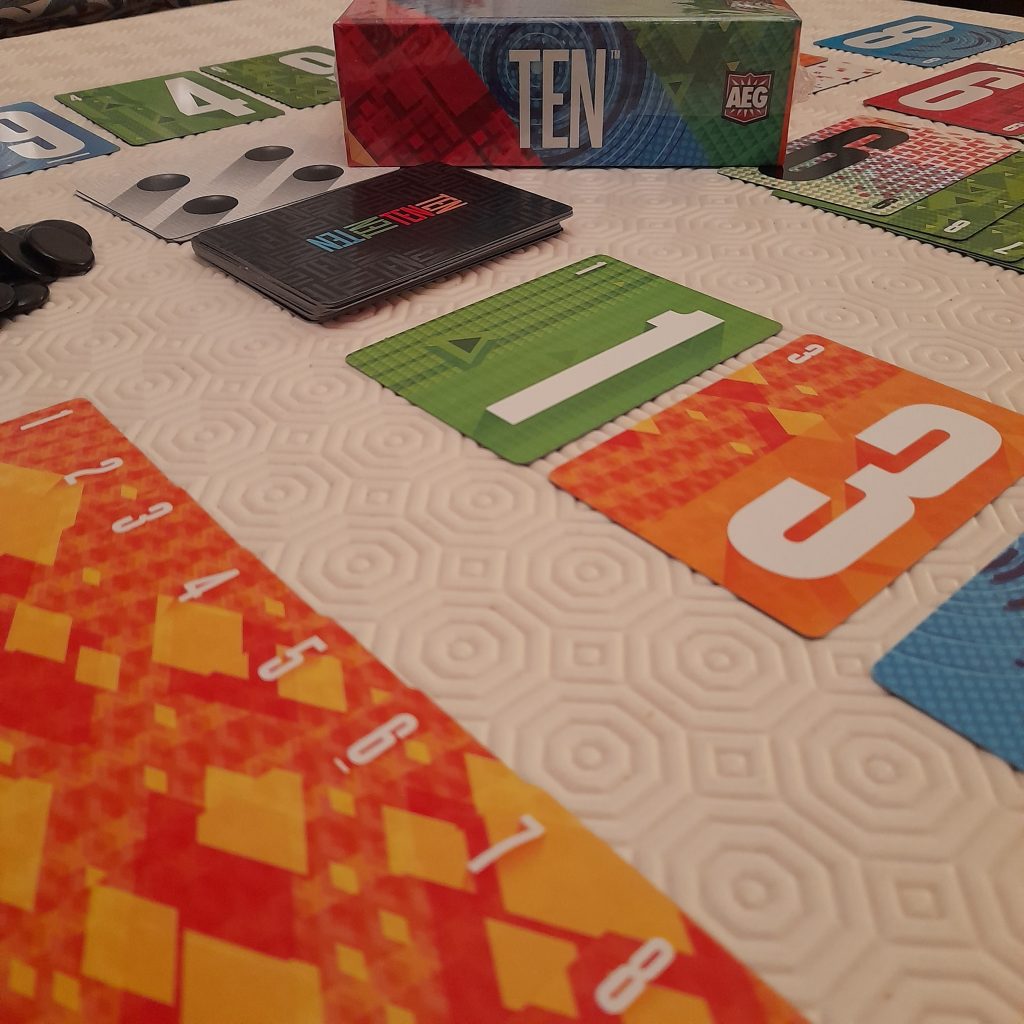
Keep Calm And Carry On!
TEN is a brilliant game. For just a deck of cards and some plastic tokens, it is much more than the sum of its parts. Set collection and hand management is the core – knowing which cards to get, which ones to keep, and which ones to sacrifice for the greater gain.
But there is also a really unexpected auction element. And, because of the way it “interrupts” normal turn service, it should be jarring, but it isn’t. There’s also the obvious push-your-luck injection. And, because of the way it feels so familiar, it should be fairly predictable, but it isn’t!
It is clever. It is taking some age-old elements, and twisting them up. Re-working them into a fun, fast, formula. And, because of that, the strategic side of this fast and furious filler is probably the most surprising thing of all.
Luck based games can often leave players at the mercy of randomness. This sits well with some, (especially when it comes to shorter, filler type games), but not others. I know I struggle to gel with games that are predominantly based on the roll of a dice, or what comes off the deck. I need at least a little control or a way to mitigate the madness!

TEN Trade-offs!
And it TEN, the opportunities to think your way around a duff flip or bad run do exist. They won’t always work, but the hope that they will is what keeps the temptation sweet!
Ultimately, you have to look beyond the number 11. You know it’s a possibility every time you turn a card. You know you need cards to win. But are they worth to you right now than currency on a given round?
Consider this. If you stick and gain number cards, but currency cards are revealed; how much buying power are you awarding other players? Would it be better to collect the currency yourself and discard the number cards? That could depend on what your opponents are collecting or if they need tokens. If they are in the line and you don’t really need these cards yourself, you could score a double hit; taking the buying power and removing those number cards from the game.
And what about that market? Should you spend up, or would you be better trying your luck at the next auction? After all, you could pick up a wild for a much lower price. Is it also worth collecting duplicate cards as additional currency for later trips to the market or bids for wild cards? Ooft, that’s a lot of think for a little box!
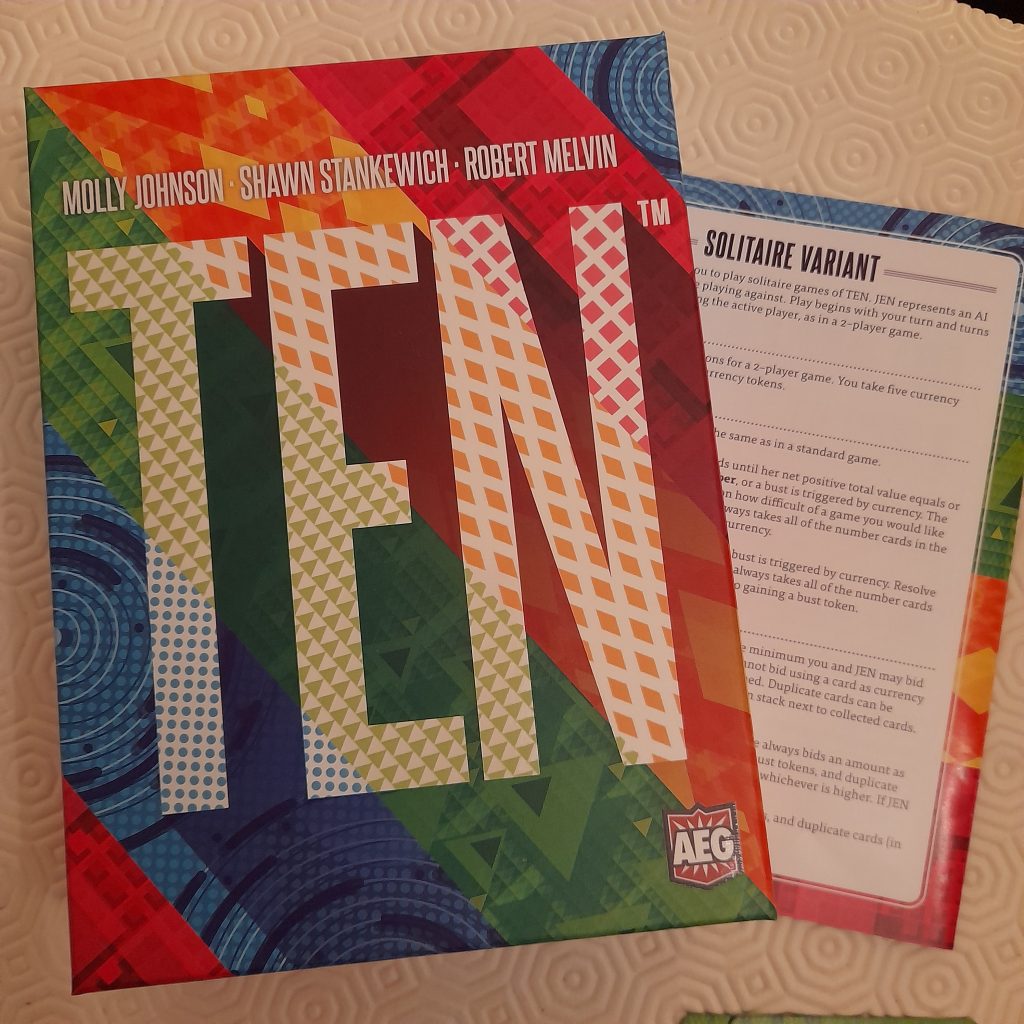
One or Two for TEN?
Another nice surprise in TEN is how well it works at lower player counts. Auction games and, to a degree, push-your-luck games can suffer a distinct lack of special sauce when there are only a few people around the table. But in TEN, the tension doesn’t dissipate. There is still that “do-I-don’t-I?” deliberation each turn. And, in a 2 player duel, knowing that you only have to outbid one other player, doesn’t make it any easier. Especially if you have been more of a spender than a saver during the game.
I should mention that JEN, the automa, is a flexible but feisty foe. With differing degrees of difficulty, and a prescribed mechanism for bidding (which depends on how many tokens both she you have on any given turn), she can be a force to reckon with when it comes to auction time!
JEN does need a little work on her behalf, and I find that does detract a teeny bit from the smooth solo experience. Not so much during the game, mind you. But at end game scoring, you will need to order her cards into sequential sets, and then total her points for the longest run in each colour. [You also need to place any wilds she gained at auction in optimum positions for scoring purposes]. The temptation to sneak a wild into a shorter run could be irresistible for some, I guess. But then again, if you do that, you’re only really cheating yourself!

TEN out of TEN?!
I love the cards in TEN. Big and glossy. But best of all, the specific pattern on each set lines up perfectly when the number cards are melded in sequence. I know, it makes no difference to the game play. But it really is a mini chef’s-kiss moment for me. Looking at the seamless design just hits a satisfying spot.
The black and white plastic currency tokens are fine – plain and functional. It may have been nice if they had a design, or at least the value (1/3) marked on them. But, in a way, their unassuming “bean” type appearance does give a nice contrast, and they let the colourful cards shine more brightly.
Most importantly of all, we also love the game play. When we want something fast that takes us to the edge without eleventy-billion chits, tokens, boards, and bits, TEN is becominga go-to push-your-luck filler.
It is frustrating in the most fun way, and we won’t deny enjoying a little saschenfraude when another player BUSTS! It hurts for an instant when it happens to you. But, with games turning around in about 15 minutes, the sting doesn’t last long. And you’d be hard pressed to hear a true groan over and above the laughter at your own and other’s misfortunes!
TEN has been as much of a surprise as it has been an instant hit at our table. I shouldn’t have been surprised really. Molly and the Flatout CoLab team together with AEG are innovation leaders when it comes to excellent easy to learn but hard to master games.
[Please note that a copy of this game ws kindly provided by the publishers for review. I am not paid for my comments, however, and all opinions are my own].

